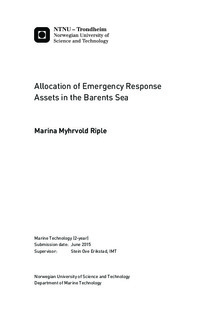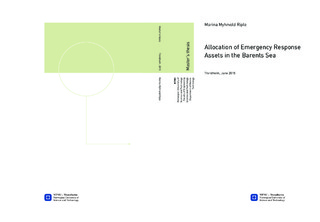| dc.description.abstract | This report presents an academic study of the allocation of emergency response assets in the Barents Sea. Operations research is utilized to examine a hub solution in order to allocate the assets.
The main strategy for oil spill preparedness is to oppose the spill as close as possible to its source, this requires a quick response time. A hub solution is introduced in order to allocate required assets for emergency response as near as possible to the operating installations. The hub will operate as an extension to the onshore base in order to reduce the response time and possibly strengthen the overall preparedness system.
The overall objective in this thesis, is to develop an optimization model in order to locate the optimal location for emergency response assets when minimizing response time. The aim is to utilize this model as an analysis tool when the hub solution for emergency preparedness in the Barents Sea is evaluated.
A general formulation of the problem is developed and presented in order to give an overall understanding of the scope and limitations to the problem. This formulation of the problem is then simplified and reformulated to a Set Partitioning Problem, and solved in two steps.
In the first step, the preprocessing phase, parameters are stated and calculated and used as input to the second step, the mathematical problem. In the preprocessing phase, the locations for the installations are decided and a hub grid is generated. The grid represents all possible locations where a hub can be located. Distances between hub locations are calculated, as well as the response time. These values are used as input for step two of the solution approach. As a final preparatory input, maximum allowable response time for the different operational phases, or critical levels are stated and bound to the operating installations. Solving the mathematical problem, one single hub is allocated at one of the generated site possibilities that meets all requirements and minimizes the response time.
As an extended analysis to this study, the emergency response model is introduced to an existing model for supplying installations. This extended study is used to investigate if a hub combination of the two purposes for hub solutions provide an added benefit.
The results presented, indicate that the response time will be considerably reduced when a hub solution is utilized, compared to serving the installations from an onshore base. With the stated requirements however, one single hub will not be able to cover the installations in all scenarios. From the extended analysis, it is indicated that storing the emergency assets on a hub supplying installations, will not affect the results for supply. | |

